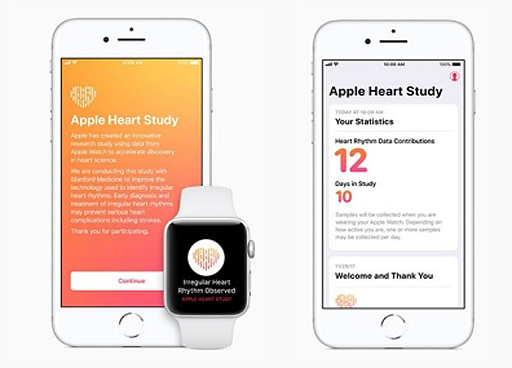Apple and Stanford show Watch can spot heart problems
- December 3, 2019
- imc

Wearable technology can safely identify heart rate irregularities that subsequent clinical evaluations confirmed to be atrial fibrillation, according to a study from Apple and the Stanford University School of Medicine.
Atrial fibrillation, a type of irregular heart rhythm, is a leading cause of stroke and hospitalisation in the USA but, due to its elusive and often sporadic symptoms, the condition often goes undetected.
With more than 400,000 participants enrolled in eight months, the Apple Heart Study is the largest virtual study to date.
“The study’s findings will help patients and clinicians understand how devices like Apple Watch can play a role in identifying atrial fibrillation, a deadly and often undiagnosed disease,” said Mintu Turakhia, associate professor of cardiovascular medicine at Stanford. “Additionally, these important findings lay the foundation for further research into the use of emerging wearable technologies in clinical practice and demonstrate the unique potential of large-scale app-based studies.”
Turakhia and Manisha Desai, professor of medicine and of biomedical data science, are the senior authors of the study. Marco Perez, associate professor of cardiovascular medicine, is the lead author. The study chair is Kenneth Mahaffey, professor of cardiovascular medicine.
The study was launched through a research sponsorship by Apple in November 2017 to determine whether software on the Apple Watch could use data from the watch’s heart-rate pulse sensor to identify atrial fibrillation, which is one of the most commonly diagnosed significant cardiac arrhythmias in the USA, affecting up to six million people.
During the study, the researchers found that only 0.52% of participants received an irregular pulse notification, assuaging concerns about potential over-notification in healthy participants. Those who were flagged for an irregular pulse received follow-up care through a heart-monitoring technique called an electrocardiography (ECG) patch, which continuously monitors electrical impulses generated by the heart, for one week.
Of those who received a notification and were monitored by the ECG patch about two weeks later, 34% were found to have atrial fibrillation. Because atrial fibrillation is an intermittent condition, it’s not surprising for it to go undetected in subsequent ECG patch monitoring. Comparison between irregular pulse-detection on Apple Watch and simultaneous ECG patch recordings showed the pulse detection algorithm has an 84% positive predictive value.
During ECG patch monitoring, participants’ Apple Watches continued to monitor pulse irregularities. If a participant had an irregular pulse detected, 84% of the time this was confirmed to be atrial fibrillation on the simultaneous ECG patch. This, said Perez, demonstrated that the algorithm in the Apple Watch could successfully identify atrial fibrillation. Information from this study could be used to inform further clinical evaluation.
The study also showed how digital health alerts could enhance engagement with the health care system overall. A survey of participants who received an irregular-pulse notification showed that 76% contacted either the telehealth provider or a non-study provider, suggesting that many actively sought medical attention as a result of an irregularity identified by their Apple Watch, said Turakhia.
“As the number of app-based health studies grows, developing additional methods to maximise self-report data accuracy and engagement will be an important area of investigation,” said Turakhia.
The design of the study provided several insights regarding patient engagement and interventions that could prove helpful in designing further studies. For one, the study’s completely virtual nature eliminated the need for participants to be physically present and allowed for the implementation of a massive recruitment strategy in a relatively short period of time. Also, because screening was done via interacting with the app, the study was administered at scale with little incremental cost.
“The performance and accuracy we observed in this study provides important information as we seek to understand the potential impact of wearable technology on the health system,” said Perez. “What the Apple Heart Study shows us is that atrial fibrillation is just the beginning. We can look ahead to other areas of preventive medicine. Further research will help people make more informed health decisions.”
To participate in the study, each individual needed an Apple Watch series one, two or three and an iPhone. The series four and five Apple Watch, which have a built-in ECG, weren’t part of the study, as they was released after the study’s launch.
The Apple Heart Study app intermittently checked the heart-rate pulse sensor for measurements of an irregular pulse. If it detected an irregular pulse, the participant received a notification and was asked to schedule a telehealth consultation with a doctor involved in the study through American Well. Participants were then sent ECG patches from BioTelemetry, which recorded the electrical rhythm of their hearts for up to a week.
Researchers from the Lankenau Heart Institute, Jefferson Medical College, University of Colorado School of Medicine, Cooper Medical School of Rowan University, StopAfib.org, American Foundation for Women’s Health and Duke University also contributed to the study.
The study was published in the New England Journal of Medicine.
• Apple has announced that its customers in the USA can enrol in three health studies – the Apple Women’s Health Study, the Apple Heart & Movement Study, and the Apple Hearing Study. Conducted in partnership with academic and research institutions, these multi-year longitudinal studies are available in the Research app, which can be downloaded from the App Store.





